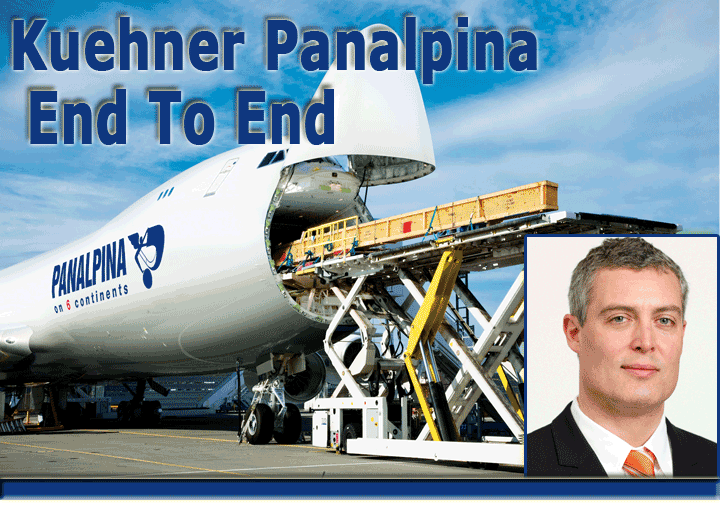With
structural overcapacity the ‘new normal’
and airlines continuing to add point-to-point capacity
to meet rising passenger demand, forwarders are understandably
seeking out profits wherever they can find them.

Panalpina
takes a holistic approach to supply chain solution provision
and, according to Lucas Kuehner, global head of air
freight, this approach naturally lends itself to revenue
generation at each stage of the transport and facilitation
process, even when airport-to-airport freight rates
are in the doldrums.
“We
are an end-to-end provider,” Kuehner told FlyingTypers.
“Even our slogan makes this clear. As it says,
we have ‘a passion for solutions.’
“Whether
it’s port to port or airport to airport, getting
cargo from one continent to another is not the difficult
part. Transit may be four days but the flying time is
a minority of this. In other words, the real difference
is made on the ground. We create added value for our
customers by giving them access to the best people,
processes, and technology so that quality is assured
and time won on the ground. “It’s
about cargo handling, real-time visibility, organizing
customs, pre-carriage documents, and doing everything
possible to smooth clearance. That’s what forwarders
do and that’s how they make a profit.
“With
so much overcapacity the airlines are struggling most,
but they are also fuelling growth because of their passenger
operations. They all treat cargo differently, but in
general they try to fill their planes and that’s
not easy in a market that’s not growing.”
““Panalpina takes a markedly different approach
to many of its rivals, not least by operating its own
charter network. But the forwarder is still predominantly
non asset-based. “For a service company, it makes
no sense to provide any service at a loss,” explained
Kuehner. “Air freight margins are not huge. They
are generated from consolidation of cargo at different
points, so we strive for critical mass. We process shipments
in a productive way, consolidate cargo on the ground
before we move to gateways, then in the gateways we
also consolidate cargo and hand it to airlines in the
most cost effective way while also meeting the transit
times of clients all along the way. Forwarders are experts
at this. It’s the same at the other end of the
chain when we deconsolidate—we make the process
as smooth as possible.
“The
role of the freight forwarder and the value we bring
to the industry often gets pushed to the wayside. We
are the ones with the contacts. We route the cargo flows
we control on behalf of shippers in a way that optimizes
the space of carriers much better than they can do themselves.
We take waste out of the supply chain.”
Panalpina’s
air freight operation incorporates an extensive charter
network, which the company views as a major differentiator
from its forwarding rivals. The network, which was first
set-up in 1990, accounts for some 15 percent of company
air freight volumes. Panalpina currently wet-leases
a Boeing 747-8 freighter from Atlas Air that makes direct
calls at five airports—Luxembourg (LUX), Huntsville
(HSV), Mexico City (MEX), Guadalajara (GDL), and Stansted
(STN)—chosen in part because they are congestion
free and offer fast turnarounds and reduced risk of
delay. Additional services using scheduled charter capacity
offer links to Shanghai Pudong, Baku, Hong Kong, and
Viracopos International Airport in São Paulo
on a scheduled basis, and multiple other destination
on an ad hoc basis.
“We
now operate more than 1,000 scheduled charter flights
a year using several partners, and our ad hoc customers
requiring a charter flight also benefit from this. They
can often avoid paying higher ad hoc rates because we
can offer them a part charter on one of our scheduled
flights,” said Kuehner.
He
explained that using leased and chartered aircraft enabled
Panalpina to offer customers guaranteed capacity, as
well as better quality control when handling sensitive
cargoes such as pharma or perishable products.
“It’s
a unique model,” he said. “In this market
we are more like an integrated freight forwarder, so
it’s different to the rest of our business. It
gives us cargo overflow and allows us to optimize our
capacity between our own long-term capacity and what’s
available in the market. But the real benefit for the
shipper is on the ground. We control the ground processes
so we know exactly how quickly cargo can be moved into
the aircraft, and for special cargoes, say for example
if we see a temperature excursion, we can act immediately
to protect the cargo. This cannot be done if the cargo
is with a ground handling agent, or on a trolley going
around the airport. We also typically do this in airports
focused on cargo not passengers, so the distance between
truck door and the plane is usually around 100 meters,
compared with a major hub where it could be about 2-3
km. This gives us full control of the supply chain for
our clients.”
The
Swiss forwarder’s first quarter results revealed
its air freight strategy is proving effective. Volumes
were up 5 percent year-on-year and Kuehner expects growth
to continue at a similar rate for the rest of the year.
“We expect increased tonnage throughout 2016,”
he said. “We are quite encouraged. Last year was
tough with the downturn in oil and gas but that’s
looking better this year and we’ve also diversified
into perishables, which has been successful.”
However,
although he expects to see Panalpina growing this year,
he is fairly bearish over the future of the global economy
and world trade.
“The
story of decreased demand and increased capacity has
been constant for the last 2-3 years and I don’t
see that changing this year or even in 2017,”
he said. “There is an overhang of 5-10 percent
capacity growth versus demand, and that puts pressure
on margins for all in the industry. It’s a fact
that we all have to live with.
“I
don’t see a huge uptake in economic growth and
trade, so this is the new normal. There are no huge
product launches that will transform the market this
year and the world economy is not in great shape. Although
it’s not terrible either, it’s humming along,
so the challenge is finding a margin.
“For
shippers this is good news as they benefit from reduced
costs. Reduced fuel prices last year also helped and
the cost of air cargo fell significantly.
“For
the industry the current market is an incentive to work
on the quality of the product in the eyes of the shipper
so that we can meet their expectations.”
SkyKing |




 Vol
15. No. 43
Vol
15. No. 43 Vol
15. No. 44
Vol
15. No. 44